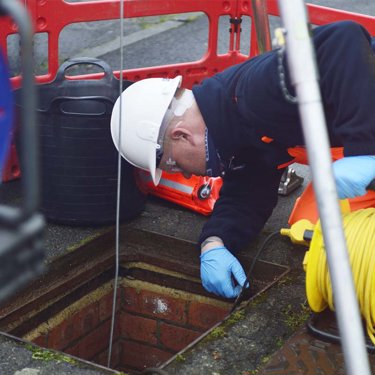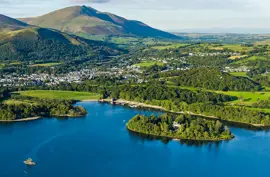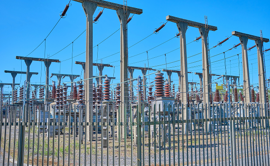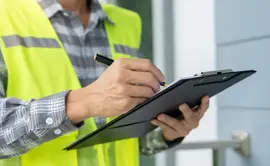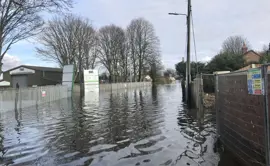The risks of not having an up-to-date site drainage plan
27 February 2024
Without properly knowing the layout, condition, and capacity of your site drainage you run the risk of operational downtime from site flooding caused by blocked drains. This is an inconvenience and can have a serious impact on your ability to generate revenue.
However, a pollution incident from contaminated surface and foul water entering the sewer and water courses is going to have far reaching repercussions from regulatory enforcement and reputation damage.
In this article we discuss the legislation that covers your drainage and how you can ensure you stay compliant.
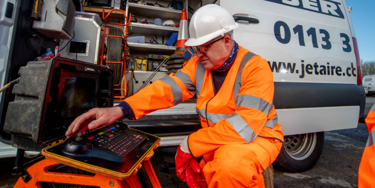
What does the law state?
There are two pieces of legislation that are relevant to your site drainage:
The Water Resources Act 1991 (as amended)
It is an offence to cause or knowingly permit any poisonous, noxious, or polluting material, or any solid waste to enter any controlled water.
And
Environmental Permitting Regulations 2016
It is an offence to cause or knowingly permit a water discharge activity or a groundwater activity without an environmental permit (regulation 38, EP Regulations 2016).
According to the definitive guidelines for environmental offences a pollution incident as a result of a wrongly specified or poorly maintained asset is a strict liability offence. Under the Sentencing Council Guideline for Environmental Offences (SCGEO), non-compliance with standards and good practice is considered an ‘aggravating factor’ and could result in the offence being categorised as ‘reckless’ or ‘deliberate’. The impact would be more stringent enforcement action and penalties, in line with the structure set out in the SCGEO. Failure to adhere can also invalidate insurance.
Standards and good practice
Site drainage can provide a primary pathway, and therefore an accurate understanding of the drainage condition and connectivity is fundamental to site environmental planning and security.
There are a number of relevant standards and good practice that apply to drainage. These include:
- CIRIA C736 Containment systems for the prevention of pollution
- GPP21 Pollution incident response planning
- WRc MSCC5 Manual of sewer condition classification
- Netregs – GPP/PPG series reference importance of accurate drainage information
- BS EN 858-2:2003 Separator systems for light liquids
- CIRIA Suds manual
In CIRIA C736 – Section 5.4.4 it states that:
A survey should be carried out if there is any uncertainty about the layout, condition, or capacity of drainage systems for trade waste. Potential hazards in terms of the systems ability to cope with major incidents should be identified. Typical hazards might include:
- combined surface and trade waste systems, especially where provided with storm overflows on or off-site
- direct runoff to surface and groundwaters (i.e. rivers and soakaways)
- infiltration of contaminants through defective drainage
- unprotected clean water gullies and other devices for collecting stormwater from areas likely to become contaminated
- inadequate or poorly maintained valves and other devices used for flow control
- defective pipes or joints
- blocked gullies, pipes and drains
If comprehensive records are unavailable or have not been maintained, the site drainage system (including surface water, foul and trade effluent systems) should be surveyed. This is normally completed by a CCTV survey that will also provide evidence of physical defects with the pipework such as broken pipes, misaligned joints, root intrusion etc.
GPP 21 Pollution Incident Response Planning section 2.2.1 states that you should have an up-to-date drainage plan including:
- Surface water drainage
- The foul sewer
- Any connections where trade effluent drains into the foul sewer
- Inspection points to detect pollution
- Oil separators/interceptors
- Pollution control devices (shut off valves/penstocks)
You should provide a description on how all facilities operate and make sure they’re clearly labelled above ground as well as noting when an inspection was last carried out on pollution control devices.
When you are drawing up your drainage plan, it is a good opportunity to check for any misconnections from your site, e.g. a foul sewer that has been linked into a watercourse. This is illegal and may lead you to respond incorrectly during a spillage.
The drainage plan should include the following key drainage features:
- Drain type – foul, storm, trade effluent, combined
- Directional flow
- Final site outfalls
- Catch pit
- Sump
- Soakaway
- Attenuation tank
- Septic tank
- Slot drainage
- ACO drains
- Gully pot
As well as key layout features:
- Operational activities
- Storage areas
- Fuelling areas
- Wash facilities
- Site topography
- Car park
What does compliance look like?
Your compliance documentation should include a site drainage plan, site layout plan with drainage features such as septic tanks/attenuation tanks/catch pits, and records of CCTV inspections.
If a recent CCTV survey report is not available, a CCTV drainage survey is recommended to confirm its condition.
If no or inadequate drainage plans are available a drainage investigation should be conducted to confirm the connectivity and key drainage features. You should identify key drainage features which are not adequately explained on the drainage plan such as sumps, attenuation tanks, septic tanks, catch pits.
Once concluded drainage plans should be kept up-to-date so that they can be produced to regulators in the event of a pollution incident.
Periodically you should review your drainage plan and consider if there are there any new activities that would affect the integrity of the drainage.
The compliance cycle
Compliance is not a one and done. All your assets and site activity should be periodically assessed to ensure ongoing compliance. This takes the form of:
- Analysis
- Investigation
- Improvement plan (0-5 years)
- Planned preventive maintenance (6-12 months)
- And Planned preventive maintenance 5 yearly and revised ESA
Remaining compliant
A pollution incident as a result of a wrongly specified or poorly maintained asset is a strict liability offence. In line with CIRIA C736, you should ensure that you have an accurate understanding of your drainage condition and an up-to-date drainage plan. A specialist drainage partner, with a keen understanding of environmental legislation, will be able to guide you though this process and ensure you remain compliant.
More from our Knowledge Hub
Here to keep your drainage flowing freely
Our experts are available now to help you understand and improve the condition of your drainage.
Speak to our experts